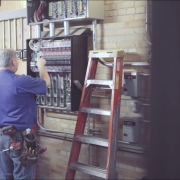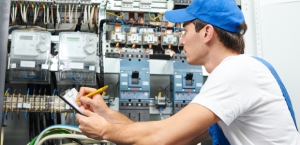Signs Your Commercial Electrical System Needs Upgraded
No matter how well your building’s electrical system was designed, there comes a time when an electrical upgrade is necessary. Upgrading your electrical system improves both the safety and utility of your building. If you find your electrical system no longer meets your needs, there are a few things to consider before contacting an electrician.
Signs You’re Due for an Electrical Upgrade
Many older buildings were designed when demand for electricity was lower. They were typically built with 60 or 120 amps and a few circuits for an entire commercial building. This was enough decades ago, but it isn’t enough to power the amount of electronics and machinery in use today. Nowadays, even small workshops require at least 200 amps.
One of the biggest signs you need an electrical upgrade is that there doesn’t seem to be enough power for everything. Your lights flicker or go out entirely when a large appliance or machine is turned on. Your equipment shuts itself off for no obvious reason. You have extension cords run between different circuits in attempt to balance the load.
You might also notice the breakers frequently trip when you try to run all the electrical equipment you need at once. You may find yourself carefully planning which equipment to use at what time in attempt to avoid tripping your breakers. Worse yet, your breakers fail and don’t trip when they should, allowing your equipment to overheat.
Safety issues are another indication your electrical system is in need of an upgrade. Check your electrical panel and wiring contacts for corrosion or other deterioration. Inspect your wiring for melted wires or melted wiring insulation. Damage like this means your building is at risk of an electrical fire. The need for surge protectors on nearly every outlet is another sign your safety could be at risk.
Even if you don’t have problems like these, consider an upgrade if you’re planning to renovate or bring in new equipment that will add to the load on your electrical system. This is especially true if you want to add air conditioning or electric heating.
Plan Ahead for Your Electrical Upgrade
Before you get in touch with an electrician, take some time to evaluate the electrical needs of your business. Make a list of the electrical appliances and equipment you currently use and any you’re planning to add, including lighting. If you’re existing lighting doesn’t allow you to work efficiently, consider upgrading to higher-voltage lighting or adding lights.
Note any areas where you’d like to have more electrical outlets, such as those where you’re currently relying on extension cords. Also consider whether you’ll be building any additions that will also need an electrical supply.
Your electrician will use this information as well as information gathered by inspecting your building to calculate your building’s total electrical load. If the only upgrade you need to your system is an additional circuit, your electrician may be able to accomplish this by adding a subpanel. This is only possible, however, when your main electrical panel already supplies enough power for the entire building and your wiring is in good condition.
Otherwise, the main electrical panel can be upgraded to provide 200 amps, 400 amps or even more if necessary.
Your electrician will need to open up sections of your walls to access your wiring, which means some noise and mess is unavoidable. Schedule your upgrade for a time when it won’t interfere with your ability to do business. While your electrician will do some basic cleanup, you’re responsible for patching and repainting your walls, so factor this into your budget.
October 30, 2020
–
Reference Source: Sobieski Services – www.sobieskiinc.com




